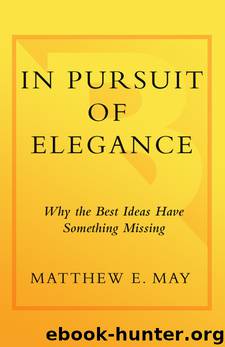In Pursuit of Elegance by Matthew E. May

Author:Matthew E. May [May, Matthew E.]
Language: eng
Format: epub
ISBN: 978-0-385-53035-4
Publisher: Crown Publishing Group
Published: 2009-04-28T04:00:00+00:00
b.
Elite sports training demands stressing muscles with steadily increasing loads, a technique widely known as progressive resistance. In fact, it demands overloading the muscles, in the sense that conventional methods work muscles to fatigue and failure in order to activate a healing process that strengthens and grows muscle fiber. But increasing the load requires increased recovery time in order to avoid overtraining. There comes a point where longer and tougher workouts simply don’t work. Returns diminish and performance can actually recede. At that point, an elite athlete’s peak level becomes unsustainable and inconsistency plagues performance.
That’s exactly what happened to champion cyclist Lance Armstrong. Going into the 2004 season, Armstrong had the opportunity to make history by becoming the first rider ever to win six Tour de France titles, and to do so in consecutive years, having the year before matched Spaniard Miguel Indurain’s record of five straight wins in the early 1990s. But Armstrong had struggled in his 2003 effort, winning the coveted maillot jaune—the yellow jersey that is the crown jewel of professional cycling—by just over a minute. Going into the 2004 season, he faced an overload challenge. The problem was that he had run out of hours in the day to train, improvement had stalled, and too much energy had been spent during the early spring months shedding the previous winter’s weight gain. Like every other pro cyclist, Lance slacked off during the winter and allowed himself to pack on a few pounds—the nemesis of anyone trying to climb a mountain on a bike. That meant focusing on weight loss for the first few months, restricting food intake, weighing food—a certain diet obsession that not only made life more unpleasant, but detracted from the very energy required to complete a six-hour training ride.
Armstrong knew from the previous year that his usual training regimen wouldn’t work anymore. The field was too young, hungry, and competitive, while he was fast approaching the twilight of a magnificent cycling career. He had attained star status, written bestselling books on his death-defying journey back from testicular cancer, and was fast becoming a global lightning rod in the fight to cure cancer. He enlisted the help of longtime ally and former Olympic coach Chris Carmichael, to devise a better strategy. Lance was attempting to do what no one else ever had, and he knew that nothing less than a complete overhaul of his traditional preparation would work.
Chris Carmichael is no stranger to cycling, to the Tour de France, or to Lance Armstrong, for that matter. Carmichael was a member of the 1984 U.S. Olympic cycling team, and later in 1986 was part of the first U.S. team to enter the Tour de France, the legendary 7-Eleven team. Carmichael suffered a career-threatening broken femur that year following the Tour, an injury from which he recovered, only to retire from racing in 1989. Insight gained from his recovery led to his interest in performance coaching, and he began working as development coach for the U.S. cycling team, coaching the 1992 and 1996 Olympic teams.
Download
This site does not store any files on its server. We only index and link to content provided by other sites. Please contact the content providers to delete copyright contents if any and email us, we'll remove relevant links or contents immediately.
Big Magic: Creative Living Beyond Fear by Elizabeth Gilbert(5609)
Paper Towns by Green John(5086)
On Writing A Memoir of the Craft by Stephen King(4863)
The Doodle Revolution by Sunni Brown(4684)
Hyperfocus by Chris Bailey(4043)
Evolve Your Brain by Joe Dispenza(3608)
Unlabel: Selling You Without Selling Out by Marc Ecko(3587)
The Red Files by Lee Winter(3366)
Draw Your Day by Samantha Dion Baker(3285)
The Power of Mindful Learning by Ellen J. Langer(3184)
The Art of Dramatic Writing: Its Basis in the Creative Interpretation of Human Motives by Egri Lajos(3014)
The War Of Art by Steven Pressfield(2868)
Applied Empathy by Michael Ventura(2836)
The 46 Rules of Genius: An Innovator's Guide to Creativity (Voices That Matter) by Marty Neumeier(2796)
How to be More Interesting by Edward De Bono(2742)
Keep Going by Austin Kleon(2696)
Why I Am Not a Feminist by Jessa Crispin(2695)
How to Stop Worrying and Start Living by Dale Carnegie(2646)
You Are Not So Smart by David McRaney(2593)
